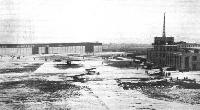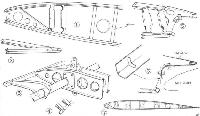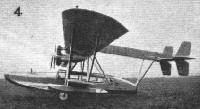Фотографии
-
NEW WINE IN OLD BOTTLES : A Breguet type 14 A.2 has recently been fitted at Cricklewood with Handley Page automatic wing tip slots. We do not know what Mr. Cordes thought of testing the machine, but the photographs show that there are plenty of other cords (a piano) on board to help in the work.
Самолёты на фотографии: Breguet Br.14 - Франция - 1916
-
One of the Aero Materiel A/B's school D.H. "Moth" (Cirrus) on skids, used during the past year for training flying club pupils in Sweden in various places.
Самолёты на фотографии: De Havilland Moth / D.H.60 - Великобритания - 1925
-
End of 18,000 Miles' Solo Flight: Lady Bailey taxying in the Cirrus-Moth at Croydon and surrounded with an admiring crowd, amongst whom were the numerous employees of the A.D.C. Aircraft Company, Ltd., whose own work had played a large part in the success of the great flight.
Самолёты на фотографии: De Havilland Moth / D.H.60 - Великобритания - 1925
-
RUSSELL "LOBE" PARACHUTE TESTS: Mr. John Tranum (right) who demonstrated Russell "Lobe" parachutes at Stag Lane Aerodrome, Edgware, on January 14, from a D.H. "Moth" flown by Capt. W. L. Hope (left). In the other views Mr. Tranum is seen descending with (centre) the 1929 type, then the 1928 type (top) and finally a smaller 1927 type.
Самолёты на фотографии: De Havilland Moth / D.H.60 - Великобритания - 1925
-
Регистрационный номер: G-EBRQ This is Mr. "Harold Brooklyn's" Westland "Widgeon" monoplane somewhere in North Africa during the course of a present air tour. He is a private owner and often carries camping kit in his machine when touring.
Самолёты на фотографии: Westland Widgeon - Великобритания - 1924
-
Germany Tests British Variable-Pitch Airscrew: A series of successful tests were recently carried out in Germany with the Gloster-Hele-Shaw-Beacham Variable-pitch airscrew, fitted to a Junkers J.34 monoplane (Bristol "Jupiter VII"), as shown in the accompanying photo.
Самолёты на фотографии: Junkers W 33 / W 34 / Ju.46 - Германия - 1926
-
Регистрационный номер: J9479 [4] THE BRITISH ATTEMPT TO BEAT THE WORLD'S DISTANCE RECORD: Three views of the Fairey Monoplane, with Napier "Lion" engine.
Самолёты на фотографии: Fairey Long-Range Monoplane - Великобритания - 1928
-
Регистрационный номер: J9479 [4] THE FAIREY LONG-DISTANCE MONOPLANE: The only place in the whole machine where members meet at a fairly small angle is near the wheel, shown on the left. The careful streamlining of the tail can be seen on the right. Note the "canoe stern." The tail plane can be trimmed, and is itself balanced so as to facilitate trimming.
Самолёты на фотографии: Fairey Long-Range Monoplane - Великобритания - 1928
-
Регистрационный номер: J9479 [4] An important item: The Napier "Lion" is extremely neatly cowled, as this view of the "nose" shows. Note also how windscreen merges into the top surface.
Самолёты на фотографии: Fairey Long-Range Monoplane - Великобритания - 1928
-
Регистрационный номер: J9479 [4] THE CREW: On the right - Squadron-Leader Arthur G. Jones-Williams, M.C., CO. of No. 23 (Fighter) Squadron, and Flight-Lieut. Eric V. Major, of No. 2, Flying Training School, Digby, who will fly the Fairey monoplane in the forthcoming attempts to beat world's records.
Самолёты на фотографии: Fairey Long-Range Monoplane - Великобритания - 1928
-
Mrs. B. Simonius, who recently took her pilot's certificate at the Basel aerodrome.
Самолёты на фотографии: Avro Avian / Type 594/616 - Великобритания - 1926
-
In this general view of Croydon Aerodrome under wintry conditions are the many machines which brought their owners to greet Lady Bailey. They include Capt. G. de Havilland's Coupe-Moth, Mr. G. A. R. Malcolm's Gipsy-Moth and Lt.-Col. L. A. Strange's Simmonds "Spartan." Also in the picture, which was taken from a "D.H." Moth piloted by Capt. A. S. White, are the "Daily Mail" "Geraldine" (D.H.61) and Alpha-Avian.
Самолёты на фотографии: Avro Avian / Type 594/616 - Великобритания - 1926De Havilland Giant Moth / D.H.61 - Великобритания - 1927De Havilland Gipsy Moth / Moth X - Великобритания - 1928Simmonds Spartan - Великобритания - 1928
-
Регистрационный номер: G-EBYO The Avro "Avian" light aeroplane salved from the River Test at Whitchurch after a crash during the Christmas holidays. It was taken charge of and dismantled at quick notice by the Agra Engineering Co., Ltd., of Teignmouth, the managing director of whom flew to the scene in another Avro "Avian"
Самолёты на фотографии: Avro Avian / Type 594/616 - Великобритания - 1926
-
AIR RESCUES IN AFGHANISTAN: The Vickers-Napier "Victoria" troop carrier, which has been instrumental in transferring the British and other European women and children from the danger zone of Kabul (Afghanistan) to Peshawar, India.
Самолёты на фотографии: Vickers Victoria - Великобритания - 1922
-
Регистрационный номер: G-EBSW These are views of the rescue of Col. the Master of Sempill's Blackburn "Bluebird" light seaplane from the grip of the ice, 3/4 in. thick, which covered the Welsh Harp at Hendon in December last. Wheels were attached after the beaching, and the machine was run up the Edgware Road to Hendon. Col. the Master of Sempill is a devotee of the light seaplane, and he always extols its use, particularly for Great Britain.
Самолёты на фотографии: Blackburn Bluebird / L.1 - Великобритания - 1924
-
THE BLACKBURN "BLUEBIRD," MARK IV: General View of the fuselage in skeleton.
Самолёты на фотографии: Blackburn Bluebird / L.1 - Великобритания - 1924
-
The Blackbird "Bluebird," Mark IV: View of the Cockpit. Note side by side seating arrangement and dual controls. The small levers placed centrally under the instrument board are the engine controls, while the central lever between the "joy sticks" trims the tail plane.
Самолёты на фотографии: Blackburn Bluebird / L.1 - Великобритания - 1924
-
THE BLACKBURN METAL "BLUEBIRD": Views of tail and nose. The engine is a de Havilland "Gipsy."
Самолёты на фотографии: Blackburn Bluebird / L.1 - Великобритания - 1924
-
THE BLACKBURN "BLUEBIRD" IV: Some constructional details of the fuselage. The general arrangement is shown on the right, while on the left are shown the details of a typical joint, shown in section in the third sketch. The stringers which support the fabric fairings are U-section strips, supported on short channel arms, as shown.
Самолёты на фотографии: Blackburn Bluebird / L.1 - Великобритания - 1924
-
Attachment of oleo leg to fuselage corner on Blackburn "Bluebird IV."
Самолёты на фотографии: Blackburn Bluebird / L.1 - Великобритания - 1924
-
THE BLACKBURN "BLUEBIRD" IV: Details of wing spar construction. A section of a main spar is shown in 1, while 2 shows how drag and interplane struts are attached. The section in 3 shows method of reinforcing spar for attachment of strut fittings. A spar end with flat plate fitting is shown in 4, while 5 illustrates the method of forming the wing tip, etc.
Самолёты на фотографии: Blackburn Bluebird / L.1 - Великобритания - 1924
-
THE BLACKBURN "BLUEBIRD IV": The main wing ribs are of Duralumin and take the form shown in 1 and 2. The Bristol-Frise ailerons are illustrated in 3 and 4. The manner of attaching the fabric over the rear spar to house the aileron is shown in 5 and 6, while 7 shows a complete rib.
Самолёты на фотографии: Blackburn Bluebird / L.1 - Великобритания - 1924
-
THE BLACKBURN "BLUEBIRD IV": Details of the tubular engine mounting. The actual engine bearers are of channel section, and tilted to simplify attachment to the tubes. The "feet" on the engine are sloped to correspond.
Самолёты на фотографии: Blackburn Bluebird / L.1 - Великобритания - 1924
-
Blackburn "Bluebird" Mk.IV D.H. "Gipsy" Engine
Самолёты на фотографии: Blackburn Bluebird / L.1 - Великобритания - 1924
-
THE CHICAGO AERO EXPOSITION: One of representative types of aircraft out of the seventy odd on view - (1) Curtiss "Robin" 3-seater monoplane (170 h.p. Curtiss "Challenger ").
Самолёты на фотографии: Curtiss Robin / Model 50 - США - 1928
-
A FAIREY SEAPLANE: Two views of the Fairey III F (Lorraine engine) fitted with float undercarriage carrying out tests at Hamble.
Самолёты на фотографии: Fairey Fairey IIIF - Великобритания - 1926
-
AT THE CHICAGO AERO SHOW: During the show some 200 aircraft gave practical demonstration at the Chicago Airport. On photo, Lady Heath is shown about to try out the Fairchild 21 light 'plane
Самолёты на фотографии: Fairchild Model 21 - США - 1928
-
The Fairchild "21" 80 hp Armstrong-Siddeley "Genet" Engine
Самолёты на фотографии: Fairchild Model 21 - США - 1928
-
Регистрационный номер: J9772 A NEW TRAINING MACHINE: Three views of the Hawker "Tomtit" all-metal biplane. Note the pronounced stagger and slightly backswept wings. The engine is an Armstrong-Siddeley "Mongoose"
Самолёты на фотографии: Hawker Tomtit - Великобритания - 1928
-
THE HAWKER "TOMTIT" IN FLIGHT: Mr. Bulman shows various aspects of the new training machine
Самолёты на фотографии: Hawker Tomtit - Великобритания - 1928
-
THE CHICAGO AERO EXPOSITION: One of representative types of aircraft out of the seventy odd on view - (3) Keystone-Loening Amphibian Air Yacht (500 h.p. Wright "Cyclone").
Самолёты на фотографии: Loening Air Yacht - США - 1928
-
SEAWORTHINESS TESTS OF THE ROHRBACH "ROMAR": View of the machine at moorings. Note the narrow beam of the hull, and the high position of the thrust line of the three engines.
Самолёты на фотографии: Rohrbach Ro.X Romar - Германия - 1928
-
SEAWORTHINESS TESTS OF THE ROHRBACH "ROMAR": 1, Taxying in a rough sea. 2, collapse of starboard wing float strut. 3, machine swinging around, with starboard wing partly submerged. As the wing is watertight, the machine did not capsize. All these tests were carried out after the machine had dragged her moorings in a gale and drifted on to the beach, as shown in 4.
Самолёты на фотографии: Rohrbach Ro.X Romar - Германия - 1928
-
Wing float of the "Romar": This photograph shows the port float. It was the starboard float diagonal strut that collapsed.
Самолёты на фотографии: Rohrbach Ro.X Romar - Германия - 1928
-
SEAWORTHINESS TESTS OF THE ROHRBACH "ROMAR": The lower photograph shows the machine during one of the starts, while in the upper picture the photographer has caught an exciting incident as the machine leaped off the water during one of the alighting tests.
Самолёты на фотографии: Rohrbach Ro.X Romar - Германия - 1928
-
THE CHICAGO AERO EXPOSITION: One of representative types of aircraft out of the seventy odd on view - (4) Sikorsky Amphibian 8-passenger transport (two 425 h.p. Pratt and Whitney" Wasps ")
Самолёты на фотографии: Sikorsky S-36 / S-38 - США - 1927
-
THE CHICAGO AERO EXPOSITION: One of representative types of aircraft out of the seventy odd on view - (2) Mohawk "Pinto" light monoplane (60 h.p. "Velie")
Самолёты на фотографии: Mohawk MLV Pinto - США - 1928
-
Lieut.-Col. L. A. Strange, D.S.O., M.C., D.F.C. (right) and Mr. H.W.R Banting, at the Tempelhof aerodrome. Berlin, with the Cirrus-Spartan in which they flew non-stop from London in 7 hrs. 10 mins. and back in 6 hrs.
Самолёты на фотографии: Simmonds Spartan - Великобритания - 1928
-
CHRISTENING CEREMONY OF SIMMONDS "SPARTAN" PRODUCTION TYPE: In the picture on the left is Mr. O. E. Simmonds, Chairman (left), and his co-director, Lt.-Col. L. A. Strange, D.S.O., M.C., D.F.C. On the right, The Mayor and Mayoress of Southampton (Mr. and Mrs. Pugh) are trying the comfortable and spacious cockpits of the Simmonds "Spartan" (A.D.C. "Cirrus" Mk. III), Mr. Simmonds being alongside. Below is the Mayoress about to perform the christening ceremony in the usual way in the Company's Woolston works, on December 31, when a large number of guests were present.
Самолёты на фотографии: Simmonds Spartan - Великобритания - 1928
-
THE THADEN T.2: An American all-metal commercial monoplane having full cantilever wings with "variable camber" wing flaps.
Самолёты на фотографии: Thaden T-2 / T-4 - США - 1928
-
MORE BRITISH AIRCRAFT FOR FINLAND: A Gloster "Gamecock" with "Jupiter" engine, one of a batch being built for the Finnish Air Force, being tested by Mr. Saint at the Gloster aerodrome at Brockworth.
Самолёты на фотографии: Gloster Gamecock - Великобритания - 1925
Статьи
- Flight
- Flight Advertisements








































